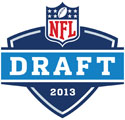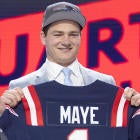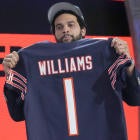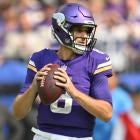Arian Foster, Alfred Morris, BenJarvus Green-Ellis and Ahmad Bradshaw combined for 5,146 rushing yards and 40 touchdowns last season.
None were drafted higher than the seventh round. Two of the four went undrafted.
So why again should NFL teams spend high draft picks on running backs?
| More 2013 NFL Draft coverage | ||
|
The theory is being put to a serious test this year, with no clear-cut first-round prospects at the position. Based on the recent evolution of the position and this year’s talent pool, it might be just as well that teams pass on backs in the first round.
Twelve rookie running backs totaled at least 250 yards on the ground last season. Three were first-round picks, two were third-rounders, two fourth-rounders, one fifth-rounder, three seventh-rounders and one undrafted player. The three seventh-round picks combined had only 110 rushing yards fewer than the three first-rounders.
A case will always be made for drafting special talents such as Adrian Peterson (seventh overall pick, 2007), Marshawn Lynch (12th pick, 2007) and Doug Martin (31st, 2012), who were three of the five leading rushers in the regular season last year. But only six of the 16 leading rushers from 2012 were former first-rounders, and many of them have battled injuries.
Peterson tore his ACL at the end of 2011 but returned brilliantly last season. Lynch turned in the first 16-game season of his career in 2012 but battled back problems throughout. Spiller averaged six yards per carry last season but has been saddled with hamstring, knee and shoulder injuries in his three NFL seasons. Chris Johnson has suffered ankle injuries in three of his four occasionally explosive pro seasons. Steven Jackson and Reggie Bush are moving onto new teams and might be in their final bursts in the league.
The shelf life of a running back is often quite short in this generation, even amid excellence on the field. And with teams opting to pass more now than ever, why spend such a high pick on what amounts to a part-time player?
This year’s crop of backs surely want to disprove the notion. But which is the best of the lot? Is there a truly elite talent available?
Alabama’s Eddie Lacy has been atop many draft boards since the end of the season, but questions about his health (hamstring) and conditioning have concerned evaluators, and there were reports that he was out of shape for his Pro Day workout on April 11. Clemson’s Andre Ellington also has battled a postseason hamstring injury, pulling it on his 40-yard dash attempt at the Scouting Combine, but says he’s now healthy and tried to convince scouts of that by running his 40-yard dashes after a full, 90-minute Pro Day workout.
North Carolina’s Giovani Bernard also has excited scouts with his big-play ability and likely has the best chance (along with UCLA’s Johnathan Franklin, Wisconsin’s Montee Ball and Michigan State’s Le’Vion Bell) to supplant Lacy as the top back drafted. Bernard faces some of the same durability concerns after missing time with various injuries, but he believes he’s a three-down back at the next level and hopes to prove that.
“I am just trying to be on the field as long as possible,” Bernard told CBS. “I don't want to be that third-down back or that change-of-pace kind of guy. I want to be a four-down back if they need that. My versatility, I think, helps me.”
But how many true three-down backs are there these days anyway?
Only five backs last season had more than 290 carries. Compare that to 10 years ago, in 2002, when 10 backs reached that plateau. More and more teams are using two and three backs to fill the role that one man formerly did. The true bellcow back, a la Peterson, is far more of a rarity these days.
One player in this year’s draft class who appeared to be atop the heap -- before injury -- and possibly a workhorse was South Carolina’s Marcus Lattimore, who scored 39 rushing TDs in 29 games in a short but brilliant college career. Now, following his second season-ending knee injury (one on each leg) in as many seasons, his stock is uncertain. Lattimore most definitely the running back wildcard in this year’s draft because he might not be available for the start of the regular season, despite shocking scouts with his rehab progress and winning over admirers at almost every step of the process.
Much like Willis McGahee (first round, 2003) and Frank Gore (third round, 2005), Lattimore could go off the board far higher than originally expected. It’s quite possible that a team with a need at running back and additional draft picks could be the one that rolls the dice on Lattimore. Keep an eye on the Rams (two first-rounders), Bengals (two second-rounders), Dolphins (two second-rounders, two third-rounders) and 49ers (two seconds, two thirds). It would be fascinating in particular if the Niners, who own 14 picks currently, pegged Lattimore to be Gore’s long-term replacement.
Much like the draft’s quarterback class, there is no certain first-round surety. But that obviously doesn’t mean there won’t be a standout, as Morris and others have shown. More than that, it perhaps reflects how the NFL now views the running back position: as one worth waiting a bit longer for on draft day. Patience, in this case, might be a virtue.





















